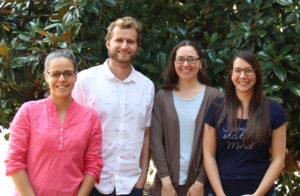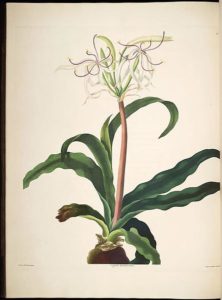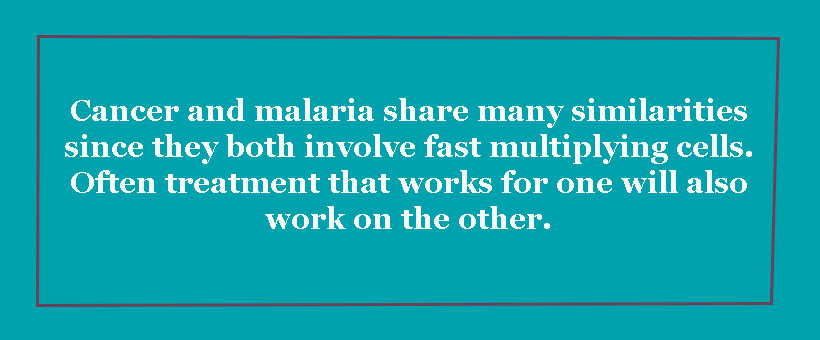The Cure for Malaria Could be in Your Backyard

Malaria is a mosquito-borne disease that has a disproportionate effect in poor and underdeveloped countries without access to western medicine. According to the WHO’s World Malaria Report, there were 212 million new cases of malaria worldwide in 2015 and an estimated 429,000 deaths.
Malaria is caused by the Plasmodium parasite. Plasmodium falciparum is the deadliest of the species infecting humans, causing 50% of all malaria cases. Unfortunately, it has become resistant to current drug treatment.
Belen Cassera and her laboratory group at the University of Georgia have been identifying possible compounds for new antimalarial medication from natural plant sources.

History of anti-malarial drugs
Malaria has long been treated with plant-based medicine. Quinine, which comes from the bark of a cinchona tree, was first isolated as an antimalarial compound in the 1800s, though there is evidence that bark extracts have been used to treat malaria since the 1600s. The cinchona tree is native to Peru.
Quinine was the treatment of choice until the 1940s when other drugs, with fewer side effects, replaced it. One of those drugs was chloroquine, which was discovered in 1934. Following World War II, chloroquine became the preferred treatment for malaria and was prominent in mass drug administration programs of the 1950s. This wide-spread use, in part, led to chloroquine resistant strains of P. falciparum.
The rise of chloroquine-resistance led to the discovery of several potential synthetic alternatives. However, in 1972 Chinese scientists isolated artemisinin from Artemisia annua, commonly known as sweet wormwood. It is native to Asia but has been naturalized in several regions including North America. It has been the main treatment of malaria in south-east Asia. However, in recent years artemisinin resistance has also emerged. (Source: History of Antimalarials)
Cassera in collaboration with David Kingston at Virginia Tech and Michael Goetz and Jason Clement from the Natural Product Discovery Institute (NPDI) has a grant from the National Center for Complementary and Integrative Health (R01 AT008088) to study plants in the NPDI Repository to identify new antimalarial compounds.
Discovering new drugs from plants
In this project, they are concentrating on plants that have not been studied for their anti-malarial properties. Also, they are looking at plants that indigenous people have used to treat the various symptoms associated with malaria.
So far over 28,000 extracts have been screened and the team has identified over 100 compounds with anti-malarial activity.
In recently published findings, the group has reported the discovery of anti-malarial compounds in Malleastrum sp., Crinum firmifolium, and Magnolia grandiflora. The first two are plants found in Madagascar, but the last one is better known as the southern magnolia and can be found in backyards throughout the southeastern United States.
From the southern magnolia extracts, the Cassera and Kingston labs identified two new compounds with anti-malarial activity. It was also discovered that it contained six compounds that have been identified in other plants as possible malaria drug compounds. An online version of the study is available: https://doi.org/10.1002/cbdv.201700209

An extract of the wood from a species of Malleastrum in the mahogany family was found to have moderate antimalarial activity against a drug-resistant strain of P. falciparum. The genus Malleastrum (Baill.) J.-F. Leroy is endemic to Madagascar and comprises 20 currently accepted species. However, there appear to be at least four previously unidentified species. The plant material in this study is almost certainly from one of the species that is still waiting to be named and described. An online version of the study is available: https://doi.org/10.1002/cbdv.201700331
Next steps in the drug discovery process
“We have identified some really promising compounds,” said Belen Cassera. “A few could be ready for pre-clinical studies in a few years.”
In addition to testing for anti-malarial activity, the Cassera lab is also looking at the mechanism of action – how the compound works. This is an important step in drug discovery; because once it is understood how the compound works a synthetic analog could be synthesized and manufactured at a cheaper cost and in a safer form.
Each compound they have identified has several molecules associated with it. In their current state, some of these compounds have too high of a toxicity to be considered for potential drug treatment. Therefore, it is important to strip the compound down to only those molecules that have potent antimalarial responses and hopefully they can remove the molecules associated with toxicity. Once this has been accomplished, then matching synthetic molecules can be created in the lab and scaled up for mass production.
 Being able to create these synthetic molecules is a necessary step in the drug discovery process. Natural material can be costly to collect or not available in abundance. While the southern magnolia seems to be abundant in the yards of Georgia, its natural range only stretches from coastal North Carolina south to central Florida, and then west to eastern Texas and Oklahoma. In addition, due to environmental differences, many times compounds isolated from a plant from one part of the world cannot be found in the same plant grown in another which reinforces the need to focus on active compounds that can be resynthesized in the lab.
Being able to create these synthetic molecules is a necessary step in the drug discovery process. Natural material can be costly to collect or not available in abundance. While the southern magnolia seems to be abundant in the yards of Georgia, its natural range only stretches from coastal North Carolina south to central Florida, and then west to eastern Texas and Oklahoma. In addition, due to environmental differences, many times compounds isolated from a plant from one part of the world cannot be found in the same plant grown in another which reinforces the need to focus on active compounds that can be resynthesized in the lab.
With the appearance of drug-resistant strains of the malaria parasite to all current medications, it is imperative new treatments be discovered. Since plant-based and traditional medicine have yielded a number of drugs historically it is likely that the next treatment option will again come from a plant source. There are countless numbers of plants that have yet to be studied for their anti-malarial uses. Belen Cassera and her team just might find the cure for malaria in your backyard.

